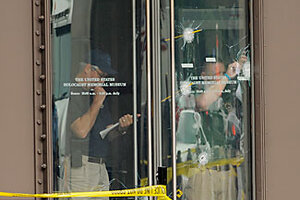Why it was so hard to prevent Von Brunn's attack
The man charged with murder in the Holocaust Museum shooting gave clear clues about his hatred of Jews on the Web. But it's hard for law enforcement to filter anger from murderous intent.

Forensic personnel inspect bullet holes in the glass entry doors at the Holocaust Memorial Museum in Washington on June 11.
Mike Theiler/Reuters
James Von Brunn told friends he was down to his last dollar. He even tried to offload his computer – his main connection to the internet fraternity of American white supremacists.
They were subtle clues, far off the FBI's radar. But on Wednesday, the former PT-boat captain and long-time anti-Semite double-parked his car outside the Holocaust Museum and allegedly shot to death the guard who thought he was opening the door to an elderly visitor. Mr. Von Brunn was critically injured when other guards returned fire. He was charged with murder on Thursday.
Police in the US can track, but can't preemptively arrest or prosecute Americans simply for the kind of hate-filled commentary that Von Brunn specialized in on the web. But added to a spate of recent right-wing extremist acts, Wednesday's attack is likely to shift local, regional and national police agencies to more closely monitor the hateful chatter that feeds the violent fantasies of would-be domestic terrorists.
Going further, the FBI on Thursday openly asked the US public to assist the agency in the Von Brunn investigation, indicating a new vigilance on the part of the agency to thwart homegrown terrorists.
"Law enforcement's challenge every day is to balance the civil liberties of US citizens against the need to investigate activities that might lead to criminal conduct," said Joseph Persichini, Jr., assistant director in charge for the FBI's Washington field office, in a press conference.
The FBI acknowledges, however, that the real counterterrorism work in the US happens at the local and state level. Often facing adversaries who are keenly aware of their free-speech rights, the challenge is to energize law enforcement agencies across the country to make domestic extremism a leading priority, experts say.
One avenue for that is through the 100 Joint Terrorism Task Forces – or "fusion centers" – set up throughout the US after 9/11. Some have already begun warning local agencies of increased extremist activity.
The wave of extremist acts began last summer:
-Jim David Adkisson has been convicted for killing two in a church in Knoxville, Tenn., on July 27, 2008. He wanted to kill Democrats in Congress, Supreme Court justices, and then-presidential candidate Barack Obama, but instead settled for the "foot soldiers" of liberalism, referring to the members of the church in a letter.
-The Bureau of Alcohol, Tobacco, Firearms and Explosives said in October that it has disrupted a skinhead plot to assassinate Obama and kill 102 black people in October.
-A Brockton, Mass., man is charged with killing two people during a rampage across the city in January. He told authorities he wanted to kill as many nonwhites as possible.
-This year, five US police officers – three in Pittsburgh and two in Florida – by individuals with links to right-wing extremism.
-An antiabortion extremist killed an abortion doctor in Kansas last week.
-Also last week, a "lone wolf" American Muslim extremist shot two Army recruiters, killing one, outside a Little Rock, Ark., mall.
In March, the Department of Homeland Security (DHS) issued a report that warned of simmering domestic extremism among the estimated 250,000 white nationalist sympathizers in the US, spurred on by tough economic times and the election of America's first black president, Mr. Obama.
Conservatives flogged the DHS for pinpointing returning veterans and even Tea Party protesters as possible extremists. But on Wednesday, Shephard Smith, an anchor on the right-leaning cable network Fox News said that DHS "was warning us for a reason."
Engaging the American people to help law enforcement isolate possible violent elements is a necessary step, experts say.
"Only a minority will be motivated to commit a violent act ... but the bad thing is it doesn't take very many people to cause a whole lot of fear," says Mark Pitcavage, an analyst with the Anti-Defamation League, which tracks hate-crimes in the US. "James von Brunn shocked far more than just Washington, D.C. [His act] reverberated across the country."
